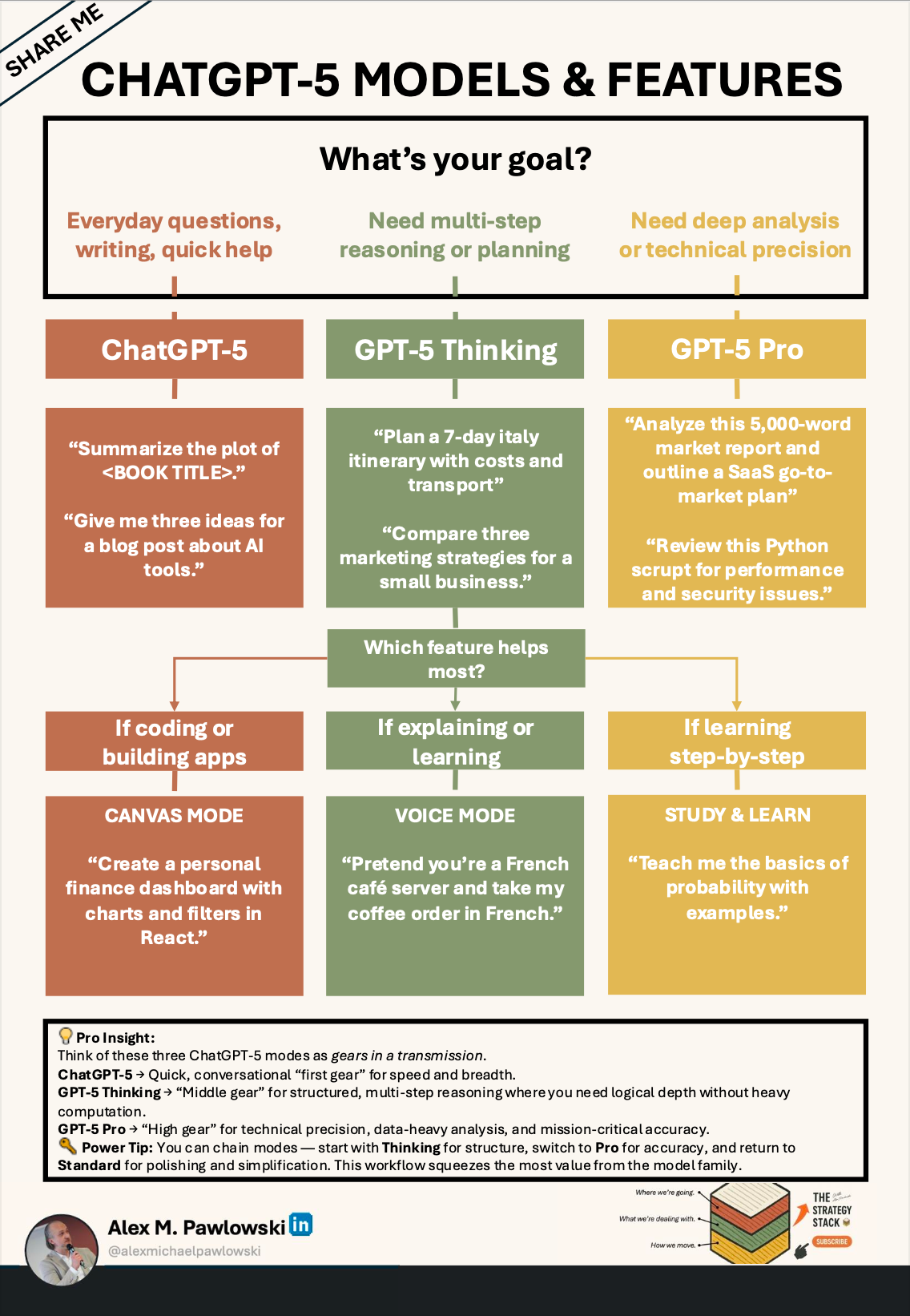Mastering ChatGPT-5: Complete Guide to Setup, Hidden Features, and Productivity Hacks
#87: Proven Strategies, Secret Commands, and Smart Prompting to Get the Most Out of ChatGPT-5
Updated Table of Contents
Introduction: Why ChatGPT-5 Changes the Game
Getting Started
2.1 Creating Your Account
2.2 Choosing the Right Plan (Free vs Plus)
2.3 Understanding the InterfaceFirst-Time Setup
3.1 Adjusting Settings for Your Needs
3.2 Personalization & Memory Features
3.3 Linking External Tools (Web Browsing, Code Interpreter, etc.)Core Skills: Talking to ChatGPT-5
4.1 Writing Effective Prompts
4.2 Using Role-Playing for Better Results
4.3 Chaining Questions for DepthPro Tips & Lesser-Known Tricks
5.1 System Messages for Custom Behavior
5.2 How to Ask for Structured Output (Tables, Lists, JSON)
5.3 Using Multi-Step Reasoning for Complex Tasks
5.4 Leveraging File Uploads for Deep Analysis
5.5 Combining Images + Text for Smarter Queries
5.6 Agentic Overdrive
5.7 Tool Preamble Magic
5.8 Invisible Self-ReflectionCommon Pitfalls & How to Avoid Them
Use Cases for Work, Creativity, and Learning
7.1 Business & Productivity
- What You Can Do
- How To
7.2 Content Creation & Research
- What You Can Do
- How To
7.3 Coding & Data Analysis
- What You Can Do
- How To
7.4 Language Learning & Skill Building
- What You Can Do
- How ToPrivacy, Safety, and Ethical Use
8.1 Protecting Sensitive Data
- Pointers
- How To
8.2 Verifying Factual Accuracy
- Pointers
- How To
8.3 Avoiding and Managing Bias
- Pointers
- How ToResources & Further Learning
9.1 OpenAI Help Center
- What It Is
- Pointers
9.2 AI Prompt Libraries (PromptHero, FlowGPT)
- What They Are
- Pointers
- Example Workflow
9.3 AI Community Forums & YouTube Tutorials
- What They Are
- Pointers
- Pro TipQuick Reference: Prompt Patterns That Work Every Time
1. Introduction: Why ChatGPT-5 Changes the Game
ChatGPT-5 isn’t just a faster, smarter version — it’s a leap toward natural, context-aware conversation. It can remember what you’ve told it (if you enable memory), work with images, analyze files, and even connect to the live web. Whether you’re a student, entrepreneur, developer, or simply curious, ChatGPT-5 can become your all-purpose assistant — if you know how to set it up and talk to it.
2. Getting Started
2.1 Creating Your Account
Visit chat.openai.com and sign up. You can use an email address or log in via Google or Microsoft.
2.2 Choosing the Right Plan
Free tier → Great for casual use, but limited to GPT-4o-mini or earlier models.
Plus plan → Unlocks GPT-5, faster responses, priority access, and better performance.
2.3 Understanding the Interface
The left panel stores your chats, the center is your conversation, and the top-right menu contains your account settings. Simple, but customizable.
3. First-Time Setup
3.1 Adjusting Settings
Go to Settings → General to tweak your theme (light/dark), text size, and accessibility options.
3.2 Personalization & Memory
In Settings → Personalization, you can:
Set your tone preference (formal, casual, technical, etc.)
Enable Memory so ChatGPT-5 can remember your style, recurring topics, or preferences between sessions.
Pro tip: You can always tell it “Forget everything we’ve discussed” or delete memory from settings.
3.3 Linking External Tools
Under Settings → Features, enable:
Web Browsing → Live, up-to-date answers.
Advanced Data Analysis → Code, charts, file parsing.
Third-Party Plugins (if available) → Integrate with external apps like Google Drive or Zapier.
4. Core Skills: Talking to ChatGPT-5
4.1 Writing Effective Prompts
Think of prompts like instructions to a very smart assistant:
✅ Specific task → “Summarize this report into three bullet points for executives.”
✅ Context → “Assume you’re a financial analyst reviewing Q2 earnings.”
4.2 Using Role-Playing
“Act as a [role] and [task]…” is one of the most reliable prompt starters. Example:
Act as a UX designer and critique my website’s layout.
4.3 Chaining Questions for Depth
Instead of asking one big question, break it into parts:
First, get an outline.
Then, expand on each section.
Finally, ask for edits or rephrasing.
5. Pro Tips & Lesser-Known Tricks
5.1 System Messages for Custom Behavior
Before your first question, set the tone:
“From now on, answer like a friendly science teacher using analogies.”
5.2 Ask for Structured Output
Tell ChatGPT-5 exactly how to format the answer:
“Give me the answer in a 3-column table with headers: Feature, Benefit, Example.”
5.3 Multi-Step Reasoning
For complex problems, instruct:
“Think through this step-by-step before giving your answer.”
5.4 File Uploads for Deep Analysis
Drag in PDFs, CSVs, or images and ask it to analyze, summarize, or visualize.
5.5 Combining Images + Text
Upload an image and give text instructions:
“Here’s a screenshot of my app — suggest three UI improvements.”
5.6 Agentic Overdrive
Command line:
Stick with the following problem, until it is solved entirely. Even if in doubt, decide yourself and document every step along the way.
Why it matters: This mode tells ChatGPT-5 to act like a determined problem-solver — it won’t stop halfway or wait for you to guide it. It keeps pushing until the task is finished, while logging each step for transparency.
5.7 Tool Preamble Magic
Command line:
Repeat my goal, create a step plan and report live.
Why it matters: Perfect when you want to ensure ChatGPT-5 fully understands your intent before starting. It restates your goal, builds a step-by-step plan, and reports progress live — almost like a mission dashboard.
5.8 Invisible Self-Reflection
Command line:
Create an internal 7 point list for peak quality, check and improve until all points are fulfiled - don't show me the list
Why it matters: This enables ChatGPT-5’s hidden quality-control mode. It silently applies a rigorous 7-point checklist before you see the answer, polishing it without you having to request revisions.
Keep reading with a 7-day free trial
Subscribe to The Strategy Stack to keep reading this post and get 7 days of free access to the full post archives.


